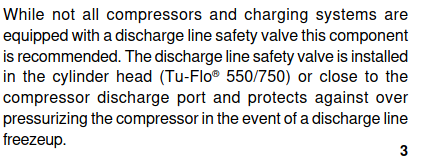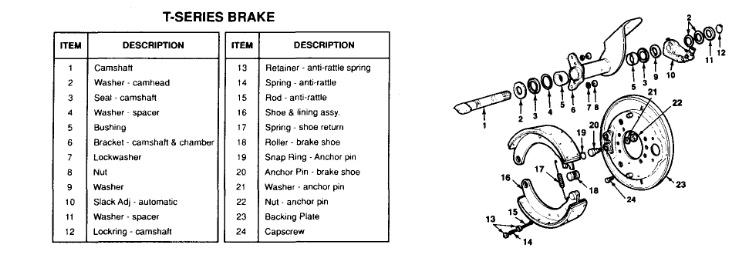
Geoff Weeks
Pedigreed Bulldog-
Posts
2,102 -
Joined
-
Last visited
-
Days Won
7
Content Type
Profiles
Forums
Gallery
Events
Blogs
BMT Wiki
Collections
Store
Everything posted by Geoff Weeks
-
-
The earlier compressors in the Tru-Flo series, TF500,600, 700 and TF501 I don't think had the provision for a relief the TF 550 I believe does. It is a later compressor. I still have some 500 and 700 models, I'll have to check if I have a 501.
-
P.S. glad it worked for you. disconnecting the line and running at high speed is kind of a "hail Mary" type situation, may work, but sort of last ditch effort before pulling the compressor.
-
I don't think the TF501 has that. Replace the elbow from the tube with a T fitting and a pipe to flare adapter and put the relief valve there. Also inspect or replace the copper line. If the head had carbon build up good chance the copper line does also. Be sure to use a high temp relief valve as the outlet temp can be quite hot
-
Here is a link to the manual, but they barely mention the T brake. Brake manual
-
They are "obsolete" but I liked them better than the Q's because they held the shoe in position better with the pin and loop on the bottom end. My 1989 had them but it was likely the last year to use them. The "nail and spring" are just there to hold the shoe against the backing plate. There shouldn't be a whole lot of force, just enough to prevent the shoe from "rattling" against the plate when the brakes are released. The above diagram doesn't show two spring on the nail, only one. One is all I have seen also.
-
I just saw you have spring between the backing plate and the shoe as well as on the shoe to cap side. I have never seen spring on the "inside" the shoe rested on pads on the backing plate, much like a car does. So only one spring on each "nail".
-
Looks right to me.
-
these are the type with a pin (loop) at the bottom and a single return spring across the cam end, with "brake nails" mid way that have a spring and a retainer that you compress and make a 1/4 turn correct? I have had problems with the nails/retainers not being right. Other than that, they are like old drum brakes on cars, not much to them. Photo of the problem might help.
-
If the unloader is stuck, it holds the intake valves open, not the exhaust, so it would not leak back from the tanks when the truck is turned off. It does sound like the exhaust valves are leaking . I would likely remove the outlet fitting and run the truck a max rpm and try and "blow out" any debris that might be keeping the valves from closing. Doing this will pass the max amount of air through the valves. Anything else will require pulling the compressor and/or head.
-
What little I can make out it is a TF-501 Bendix. One of the most common for its day.
-
Did you take the air gov off? (thing bolted to the left side of the compressor) and try it? I see way more gov problems then I do compressor problems.
-
Bendix
-
1972 Loadstar , my love for loadstars continues .
Geoff Weeks replied to 85snowdog's topic in Other Truck Makes
The 4300 Transtar and 9300 conventionals shared the cab. The Transtar cabovers didn't share with the 9670 which replaced them. The 9670 was more "squared off" but had less wind resistance than the 4070. -
1972 Loadstar , my love for loadstars continues .
Geoff Weeks replied to 85snowdog's topic in Other Truck Makes
IHC used to have deep "fish belly" frames that were more expensive to produce but made for a stronger truck, beefing the frame up inbetween axles where it is most subject to flexing. I was not talking about looks, so much. I am talking about sturdy, well thought out. I did my biggest moves with a single frame IHC truck that was fish belly. 169K. Older trucks had back to back cross members, newer are single. Bolts and rivets have been replaced with Huck-bolts which make assembly quick but are harder to repair. As difficult as a rivet but without the advantages of rivets. -
1972 Loadstar , my love for loadstars continues .
Geoff Weeks replied to 85snowdog's topic in Other Truck Makes
IHC's history in on road trucks and tractors is in interesting one. In the late 70's through the early 90's they offered the Brougham and Eagle trim as top of the line O/O spec's, while still holding onto the vocational and fleet market. White, GMC (and Chevy), Mack, Brockway, and Ford didn't really have anything that directly crossed. Unfortunately for IHC, these O/O spec'd trucks were still looked down on as "Barnyard Cadillac's". Once Freigthliner started going after the fleet market in a big way (IHC's bread and butter) they really pulled out of the higher end and got into a race for the bottom with Freightliner that continues to this day. With the ending of the 9300,9600,9700, 9800 series, it was IHC's exit from the O/O market in the US. The Cabovers were(are?) still made overseas. -
1972 Loadstar , my love for loadstars continues .
Geoff Weeks replied to 85snowdog's topic in Other Truck Makes
I maintained and sometime drove a Loadstar school bus with air brakes. still used the driveshaft mounted E brake (no spring brakes) so was an odd duck. No idea why it was spec'd like that. All I have left (other than the frame) of a Fleetstar. Grill became a vent on the building. -
If it is leaking back through the compresssor, it is the outlet (exh) valves. If the gov is mal functioning it can leak through the unloader. Try disconnecting the gov from the unloader and see if it will build. Caution: with gov disconnected it will never stop building air pressure, so don't run it all the way up. If it builds to over 60, shut it down and you know the gov is the problem.
-
1972 Loadstar , my love for loadstars continues .
Geoff Weeks replied to 85snowdog's topic in Other Truck Makes
When I was in Ma, it was all by weight, 18000 and under was a "car" lic (3?) above that was straight truck (2?) and semi was class1. That was back in the 70's Once the CDL came in, the classes were standardized. -
1972 Loadstar , my love for loadstars continues .
Geoff Weeks replied to 85snowdog's topic in Other Truck Makes
There wasn't any "requirement" other than being able to meet stopping requirements. I think the heavy dumps were marketed to county road depts. So no special training would be required. A 392 would be lucky to move that load much over 40 mph. Weird to see vacuum PDL's and brakes on those heavy axles tho. -
1972 Loadstar , my love for loadstars continues .
Geoff Weeks replied to 85snowdog's topic in Other Truck Makes
disk or spoke was up to who ordered. What is uncommon was the 10 hole disks. most would have been 6 hole. IHC was weird in someways, you could order a Loadstar heavier spec'd than a heavier class Fleetstar. Most cases the Fleetstar would be the heavier truck, but not always. As I stated earlier, I have seen tandem axle dump Loadstar's in the 40-44K GVW range, all on juice brakes. -
B 61 Spindle Locking Washer
Geoff Weeks replied to HarryS's topic in Antique and Classic Mack Trucks General Discussion
I'd likely flatten it out, heat it red hot and allow to cool slowly in sand. That should anneal it to make what is left usable. If you could hold the inner nut tight enough so you could really crank down on the outer (jamming them together) it would be good enough. Have to be careful not to change the pre-load when they are jamming, it will tend to reduce the clearance as the inner nut is pushed against its threads by the outer. -
B 61 Spindle Locking Washer
Geoff Weeks replied to HarryS's topic in Antique and Classic Mack Trucks General Discussion
I think the one I listed and you crossed to Euclid is too thick for what he needs. -
E3 to E6 trendle valve
Geoff Weeks replied to treefroggs's topic in Antique and Classic Mack Trucks General Discussion
E 3 is a single line and E-6 is a dual line system. So no, they don't directly interchange or hook up the same. -
B 61 Spindle Locking Washer
Geoff Weeks replied to HarryS's topic in Antique and Classic Mack Trucks General Discussion
Meritor doesn't sell direct Punch that number (R004868) into you search engine and see what pops up. I get a whole bunch of retailers. Just noticed the 5/32" thickness, that will not likely work for you. almost 3/16" not sure you could bend it over.
BigMackTrucks.com
BigMackTrucks.com is a support forum for antique, classic and modern Mack Trucks! The forum is owned and maintained by Watt's Truck Center, Inc. an independent, full service Mack dealer. The forums are not affiliated with Mack Trucks, Inc.
Our Vendors and Advertisers
Thank you for your support!






